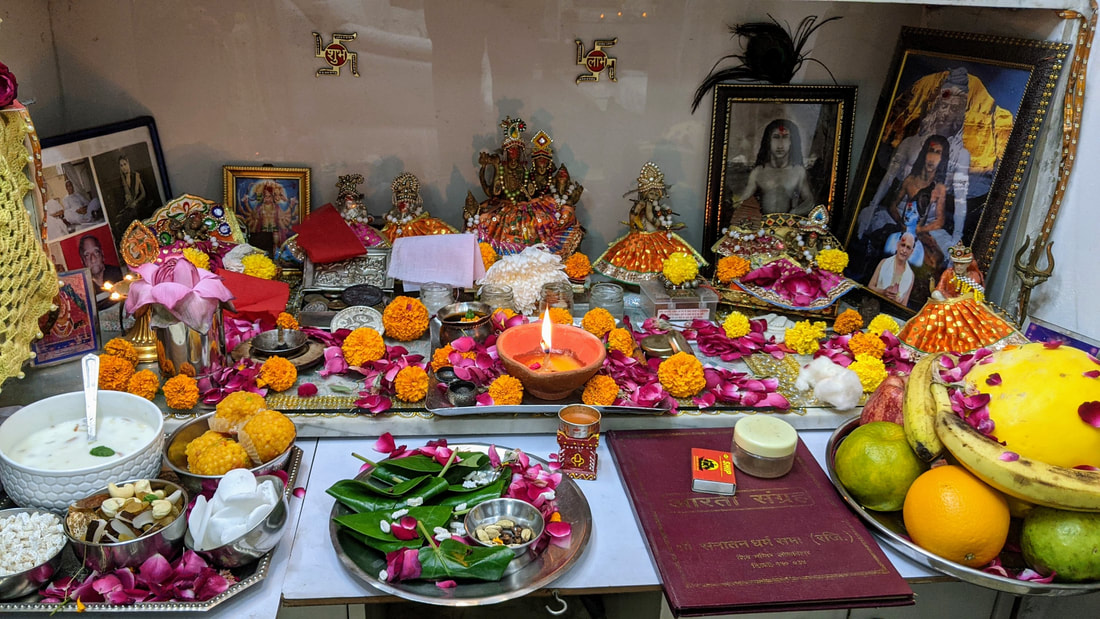|
Traditional Puja Vidhi (Ritualistic Worship)
Hinduism offers widest spectrum of spirituality, rituals, festivals and temples among all religions. Puja in Sanskrit means to adore, to worship. Ritualistic (traditional) puja disciplines the devotee and is first step to awaken the spiritual attributes dharma, righteous karma, jnana, concentration, introspection, vairagya, and bhakti. The technique involves humility and loving surrender to the Divine which is essential to eliminate ego. Ritualistic puja is so elaborate that people find it time consuming and futile exercise. But entering into each step of puja, one becomes so absorbed, physically, mentally & emotionally that he loses all his distractions. Serious devotee draws together all the five senses thereby centering the attention on performing the ritual and calming the devotee’s heart and mind through adoring focus of the chosen deity (deities) being invoked and worshiped in the ritual. Devotee develops complete concentration. Concentration helps in developing bhava (feelings, devotion) Types of Puja:
Practices in puja: Pooja involves worship, both internally and externally, worship of deities, mantras (incarnation), mandalas & yantras (magic circles), mudras (symbolic & invocative gestures), Samskaras (sacramental rites), etc. During rites and worship, mandala and Yantra which are magic circle, becomes the centre of the universe in a symbolic sense.
The ultimate aim is to transform every action in life into ritual, so that the individual performs every action and thought with a feeling of worship and awareness. Steps of traditional puja: These steps may vary according to region, tradition, setting, or time particularly in ways the deity is hosted.
Multiple deities & cosmic powers: Hinduism offers both options – Nirakara Brahman (one God, formless) and Saguna deities (several personal gods with various cosmic powers), but ultimately all deities reach to one ultimate universal Brahman. The multiple gods and goddesses of Hinduism are a distinctive feature of the religion who symbolize various cosmic powers. It provides various options of which one might touch my heart the most. The Vedic deities personify various powers through fire, wind, sun, dawn, darkness, earth and so on. The cosmic functions of creation, maintenance, and destruction are personified typically by trimurty or trideva - Brahma the creator, Vishnu the preserver of humanity & dharma, and Shiva the destroyer to regenerate. Hinduism provides believers the opportunity to satisfy all their basic desires by a set of functional deities – Sun for health, fame & power; Hanuman ji for wisdom, power, freedom from fear, love & devotion; Saraswati mata for wisdom including music & learning; Lakshmi mata for wealth & fortune; Durga mata & kali mata for power; Ganesh ji for Success & remover of obstacles; Annapoorna mata for food; Radha ji for love & devotion; Shree Krishna for Love & preserver of dharma; Shree Ram for equanimity and justice, ideal son, brother, husband, and king and as a strict adherent to dharma A select Mantras of personal deities are given hereunder: Sun:
· वक्रतुण्ड महाकाय सुर्यकोटि समप्रभ: निर्विघ्नं कुरु मे देव सर्वकार्येषु सर्वदा Shiva ji: · ॐ त्र्यम्बकं यजामहे सुगन्धिं पुष्टिवर्धनम | उर्वारुकमिव बन्धनान्मृत्योर्मुक्षीय मामृतात् || · कर्पूरगौरं करुणावतारं संसारसारं भुजगेन्द्रहारम् । सदा बसन्तं हृदयारबिन्दे भबं भवानीसहितं नमामि ॥ Vishnu ji: · ॐ नमोः नारायणाय.ॐ नमोः भगवते वासुदेवाय ।:।|| · शान्ताकारं भुजगशयनं पद्मनाभं सुरेशं विश्वाधारं गगनसदृशं मेघवर्ण शुभाङ्गम् । लक्ष्मीकान्तं कमलनयनं योगिभिर्ध्यानगम्यम् वन्दे विष्णुं भवभयहरं सर्वलोकैकनाथम् ॥ · त्वमेव माता च पिता त्वमेव|त्वमेव बन्धुश्च सखा त्वमेव |त्वमेव विद्या द्रविणं त्वमेव|त्वमेव सर्व मम देवदेव || Hanuman ji: · मनोजवं मारुततुल्यवेगम् |जितेन्दि्रयं बुद्धिमतां वरिष्ठम् |वातात्मजं वानरयूथमुख्यं |श्री रामदूतं शरण प्रपद्ये || Navagrah: · ॐ ब्रह्मा मुरारिस्त्रिपुरान्तकारी, भानुः शशी भूमिसुतो बुधश्च । गुरुश्च शुक्रः शनिराहु केतवः, सर्वे ग्रहा शान्तिकरा भवन्तु Durga mata: · सर्व मंगलमांगल्ये शिवे सर्वार्थसाधिके शरण्ये त्र्यंबके गौरी नारायणि नमोस्तुते । · या देवी सर्वभूतेषु माँ रुपेण संस्थिता |या देवी सर्वभूतेषु शक्ती रुपेण संस्थिता |या देवी सर्वभूतेषु बुद्धि रुपेण संस्थिता|या देवी सर्वभूतेषु लक्ष्मी रुपेण संस्थिता |नमस्तस्यै नमस्तस्यै नमो नमः Lakshmi mata:
Gayatri mata:
Guru: · गुरु - गुरु ब्रह्मा, गुरु विष्णु गुरु देवो महेश्वर, गुरु साक्षात् परमं ब्रह्मा तस्मै श्री गुरुवे नम:। Shanti Mantra: · ॐ द्यौः शान्तिरन्तरिक्षं शान्तिः पृथिवी शान्तिरापः शान्तिरोषधयः शान्तिः।वनस्पतयः शान्तिर्विश्वेदेवाः शान्तिर्ब्रह्म शान्तिः सर्वं शान्तिः शान्तिरेव शान्तिः सा मा शान्तिरेधि ॥ ॐ शान्तिः शान्तिः शान्तिः ॥
0 Comments
|
Archives
July 2024
Categories |

 RSS Feed
RSS Feed